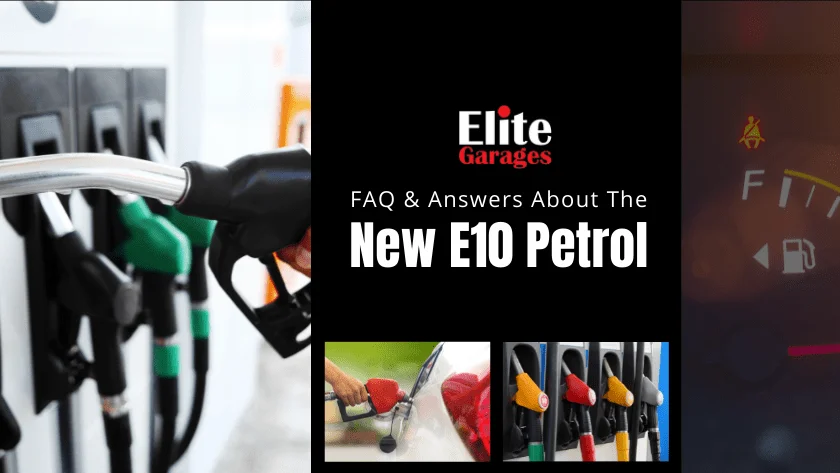
FAQ About The New E10 Petrol
As part of the bid to reduce CO2 emissions, E10 petrol will be available at UK petrol stations from September 2021. This more eco-friendly type of petrol contains up to 10% ethanol which will reportedly help the UK reach its goal of net-zero carbon by 2050.
Considering the higher level of ethanol, it may not be compatible with all cars which means there are many questions. In this post, we will answer some of the more prominent ones along with some sound advice on best practices.
What Is E10 Petrol?
The ethanol used in E5 petrol and E10 petrol is bioethanol which means it is a renewable fuel. It’s derived from growing and fermenting crops such as sugar, wheat, maize and waste wood. As such, E10 petrol is a mixture of standard petrol and ethanol.
What’s The Point Of E10 Petrol?
The higher level of ethanol reduces carbon dioxide as it produces less CO2 compared to petrol. Add to that the crops used to produce it also absorb CO2 from the atmosphere makes E10 petrol a “greener” alternative.
In addition to the 2050 goal of reaching net-zero carbon, E10 petrol will also boost the country’s biofuel industry as the materials needed are refined in the UK. Blending renewable ethanol with fossil petrol is also making valuable by-products such as animal feed and stored CO2; all of which helps fight climate change.
Experts believe it could cut CO2 emissions on UK roads by as much as 750,000 tonnes per year. To put that into perspective – it’s like removing 350,000 cars off the roads entirely.
Which Cars Are Not Compatible With E10 Petrol?
Whilst most cars will automatically be compatible with the new E10 petrol, owners of cars made before 2011 should pay close attention. We recommend double-checking with your manufacturer before filling up as long-term use of E10 will have severe consequences. Not only can it damage your engine but there is also an increased fire risk especially in classic cars.
According to RAC breakdown service and Department for Transport (DfT), between 600,000 and 700,000 vehicles on UK roads may not be compatible with E10 petrol. Fortunately, all cars produced after 2011 were made to accept E10 petrol which will hopefully help the UK meet its ambitious emissions targets. To see if your car is incompatible with E10, simply use the E10 online checker.
Can I Still Get E5 Petrol?
It’s important to note that the standard (‘95 octane) petrol grade in Great Britain will become the new E10 petrol. This only applies to petrol as diesel fuel remains unchanged. If your petrol vehicle or equipment can’t use E10 fuel, you can still use E5 by purchasing the ‘super’ grade or ‘97+ octane petrol from most petrol stations. To make it easily identifiable, petrol pumps will clearly label petrol as either E10 or E5.
Can I Mix E5 and E10?
If your car can take E10, there shouldn’t be any reason not to mix E5 97+ and E10 95+. According to government guidance, it’s safe to mix the two in the same tank or fill up with E5 when E10 is unavailable.
What Happens When My Car Is Not Compatible With E10?
Accidentally filling up with E10 is not as bad as putting diesel into a petrol car. As you may know, when this happens you need to drain and clean the entire tank. If you used E10 once by accident, it shouldn’t cause too many problems but you have to fill up with E5 (‘97+ octane) when it gets halfway. Prolonged use of E10 in an incompatible car is not only damaging your engine but also poses potential fire hazards.
Can I Use E10 In Classic Cars?
Whilst many classic cars currently run on the E5 petrol, the new E10 fuel can cause problems. According to a DfT analysis, some potential issues include the following:
- Blocked fuel filters and injectors
- Damaged fuel pumps
- Degraded fuel hoses and seals
- Corroded carburettors and fuel tanks
Since ethanol is a solvent, it eats through rubber, plastic and even fibreglass. Ethanol also absorbs water from the air so when this water gets into your car it can cause condensation in the fuel tank, fuel lines and carburettors.
Same as any other incompatible car, if you filled up with E10, make sure to top up with E5 when your tank is about half. Remember, this only applies if you regularly use the car as you should never leave E10 petrol in the tank if you’re putting it into storage.
Recommended: ‘Questions And Answer When Using E10 In Historic Vehicles‘
Will E10 Be More Expensive?
Despite estimates suggesting E10 could cost 0.2p less per litre than E5, the new petrol has a lower energy content. That means you’ll need to stop at the petrol station more often which offsets any real savings.
Also, those having to use E5 (‘97+ octane) could pay between £6 and £7 more per tank of E5 petrol in a standard family car. How well the widespread adoption of E10 petrol goes remains to be seen but any attempt to reduce emissions should be applauded.
For more information about our wide range of services, free vehicle safety checks and where to find us, simply visit our website. You can also book a service, MOT, reserve tyres or arrange a free vehicle safety check.
About Us
Opening Times
Saturday : 8:30–4:00
Sunday : closed
More Information
Contact UsCustomer Information Pack
Check MOT Due Date
Free MOT reminder
Careers
Legal Information
Recent Posts
- Christmas Guide to Winter Car Checks: From All of Us at Elite Garages
- Want to Prevent Exhaust Damage and Reduce Emissions?
- Regular Car Maintenance: Joe Achilles Tests Elite Garages’ 250,000-Mile BMW
- Clutch Replacement Near Me: A Comprehensive Guide for UK Drivers
- Antifreeze Coolant: What It Is, How It Works, and When to Use It


